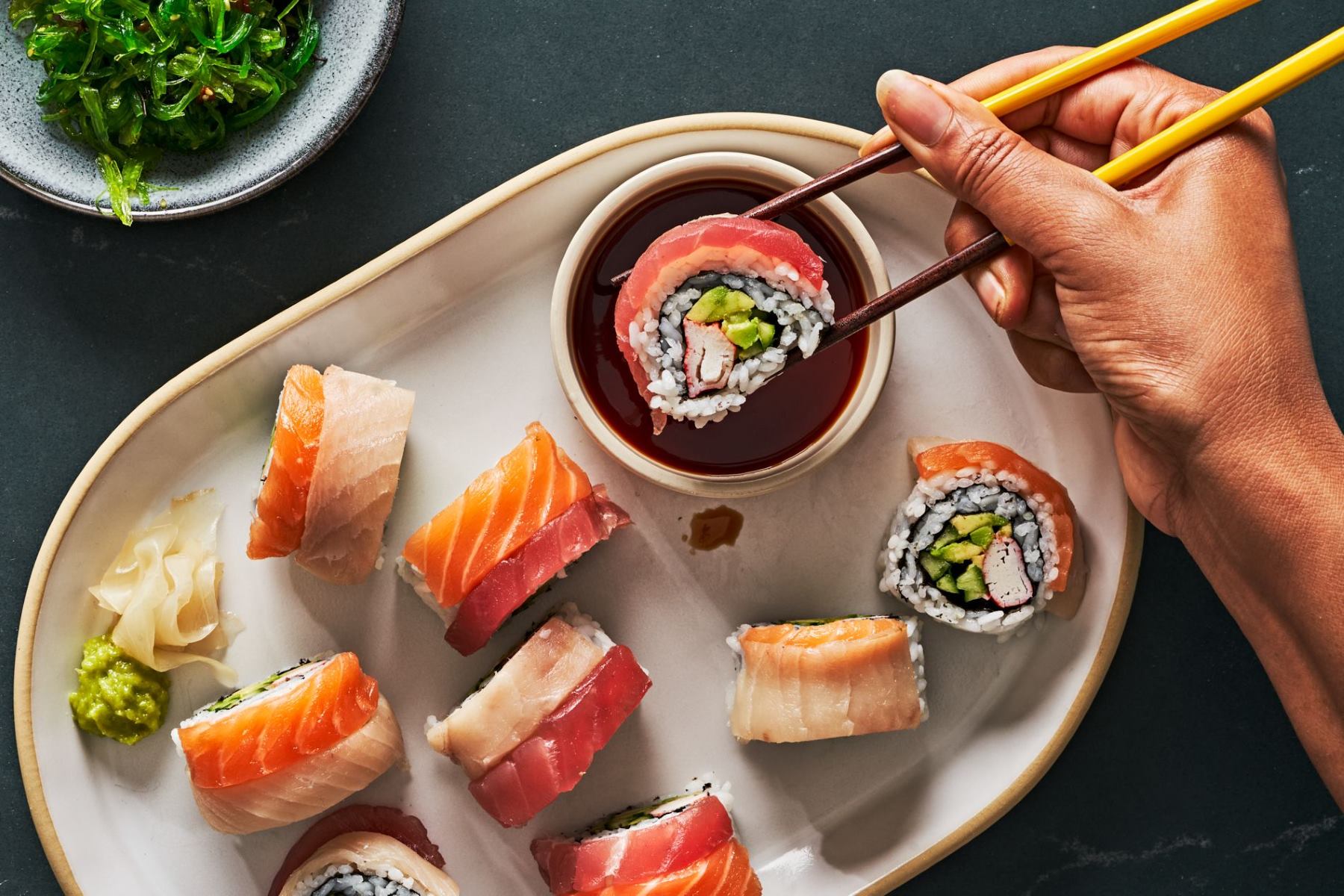
Welcome to our comprehensive guide on Rainbow Roll nutrition facts! If you’re a sushi lover or someone who enjoys exploring different types of Japanese cuisine, chances are you’ve encountered the Rainbow Roll at your favorite sushi restaurant. This colorful and visually appealing sushi roll has become a popular choice thanks to its unique combination of flavors and vibrant presentation.
In this article, we will dive into the nutritional aspects of the Rainbow Roll, analyzing its ingredients and breaking down its macronutrient and micronutrient content. Whether you’re curious about the calorie count, protein content, or vitamin and mineral composition, we’ve got you covered.
So, if you’re ready to discover the nutritional benefits of the Rainbow Roll while satisfying your sushi cravings, let’s embark on this delicious and informative journey!
Key Takeaways:
- The Rainbow Roll is a colorful and delicious sushi option that is low in calories, high in protein, and packed with essential nutrients like omega-3 fatty acids and vitamins. It’s a guilt-free and nutritious treat for sushi lovers!
- With its vibrant colors and rich flavors, the Rainbow Roll offers a balanced combination of healthy fats, antioxidants, and essential minerals. It’s not only a tasty sushi choice but also a nutritious addition to a well-rounded diet.
Low in Calories
The Rainbow Roll is a relatively low-calorie option compared to other sushi rolls. With an average of 250-300 calories per serving, it can be enjoyed as a guilt-free treat.
Rich in Omega-3 Fatty Acids
The Rainbow Roll contains seafood ingredients like salmon and tuna, which are excellent sources of omega-3 fatty acids. These healthy fats have numerous benefits for heart health and brain function.
Packed with Protein
Thanks to the inclusion of fish and seafood, the Rainbow Roll is a protein-packed meal. It provides a good amount of essential amino acids needed for muscle repair and growth.
High in Vitamins and Minerals
This sushi roll is loaded with various vitamins and minerals, including vitamin A, vitamin C, potassium, and selenium. These nutrients contribute to overall well-being and support a healthy immune system.
Source of Fiber
The Rainbow Roll often includes ingredients like cucumber and avocado, which are rich in dietary fiber. Fiber aids in digestion and helps to keep you feeling full and satisfied.
Contains Antioxidants
The colorful vegetables and fish in the Rainbow Roll are packed with antioxidants. These compounds help protect cells from damage and reduce the risk of chronic diseases.
Balanced Macro and Micronutrients
The Rainbow Roll offers a balanced combination of carbohydrates, proteins, and fats, along with essential micronutrients. It can contribute to a well-rounded diet when consumed in moderation.
Gluten-Free Option
If prepared with gluten-free soy sauce and without any added ingredients containing gluten, the Rainbow Roll can be enjoyed by those following a gluten-free diet.
Low in Sodium
Compared to other sushi rolls, the Rainbow Roll tends to be lower in sodium content. This makes it a suitable choice for individuals monitoring their sodium intake.
Contains Healthy Fats
Avocado, a common ingredient in the Rainbow Roll, provides monounsaturated fats, which are heart-healthy and can improve cholesterol levels.
Potential for Vitamin D
The Rainbow Roll, if made with fish like salmon, can provide a good source of vitamin D. Vitamin D is essential for bone health and immune function.
Rich in Iron
The Rainbow Roll contains iron from fish and seafood. Iron is vital for the transportation of oxygen in the body and plays a crucial role in energy production.
Moderate in Carbohydrates
The Rainbow Roll contains carbohydrates from rice and vegetables. It offers a moderate amount of energy to keep you fueled throughout the day.
Heart-Healthy Option
The Rainbow Roll, with its combination of lean protein and healthy fats, can be part of a heart-healthy diet when consumed as part of a balanced meal plan.
Boosts Brain Health
The omega-3 fatty acids in the Rainbow Roll have been shown to support brain health and cognitive function, making it a brain-boosting food option.
Low in Saturated Fat
The Rainbow Roll is generally low in saturated fat, which can contribute to maintaining healthy cholesterol levels and reducing the risk of heart disease.
Suitable for Weight Management
The Rainbow Roll, being relatively low in calories and packed with nutrients, can be enjoyed as part of a weight management plan or a balanced diet.
Contains Essential Trace Minerals
The Rainbow Roll provides essential trace minerals like iodine and zinc, which are important for proper thyroid function and immune system support.
Delicious and Satisfying
Above all, the Rainbow Roll is a delicious and satisfying sushi roll that can be enjoyed by sushi enthusiasts of all ages. It offers a delightful combination of flavors and textures.
So next time you’re at a sushi restaurant, don’t hesitate to order the Rainbow Roll. Not only does it bring a burst of color to your plate, but it also provides a range of nutritional benefits that contribute to a well-rounded diet.
Conclusion
The Rainbow Roll is not only a visually stunning dish, but it also offers a range of nutritional benefits. Packed with fresh ingredients like fish, avocado, and vegetables, the Rainbow Roll provides a healthy dose of protein, healthy fats, vitamins, and minerals. The combination of omega-3 fatty acids from the fish and the fiber from the vegetables makes it a nutritious choice for sushi lovers.
However, it’s important to be mindful of portion sizes and the accompanying soy sauce and wasabi, as they can add extra sodium to your meal. Moderation is key when enjoying this delicious sushi roll.
FAQs
1. How many calories are in a Rainbow Roll?
The number of calories in a Rainbow Roll can vary depending on the size, ingredients used, and the specific sushi restaurant. On average, a Rainbow Roll can range from 300 to 500 calories per serving.
2. Can I enjoy a Rainbow Roll if I’m on a gluten-free diet?
Yes, it is possible to enjoy a gluten-free version of the Rainbow Roll. Many sushi restaurants offer gluten-free soy sauce or can prepare the roll without using soy sauce altogether. It’s always recommended to inform the sushi chef about any dietary restrictions or allergies.
3. Are there any vegetarian options for the Rainbow Roll?
Yes, there are vegetarian variations of the Rainbow Roll available. Instead of fish, vegetarian options may include ingredients like cucumber, avocado, and various vegetables. These rolls still offer a burst of colors and flavors, making them a delightful choice for vegetarians.
4. Can I substitute the fish in the Rainbow Roll with cooked options?
Yes, if you prefer cooked fish or are concerned about consuming raw fish, you can request cooked fish as a substitute in the Rainbow Roll. Many sushi restaurants will accommodate this request and provide a cooked fish option for you to enjoy.
5. Is the Rainbow Roll suitable for people with seafood allergies?
Unfortunately, the Rainbow Roll contains fish and may not be suitable for individuals with seafood allergies. It’s crucial to check with the restaurant or speak to the sushi chef about any special dietary needs or allergies you have to ensure a safe and enjoyable dining experience.
Was this page helpful?
Our commitment to delivering trustworthy and engaging content is at the heart of what we do. Each fact on our site is contributed by real users like you, bringing a wealth of diverse insights and information. To ensure the highest standards of accuracy and reliability, our dedicated editors meticulously review each submission. This process guarantees that the facts we share are not only fascinating but also credible. Trust in our commitment to quality and authenticity as you explore and learn with us.


